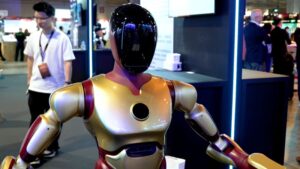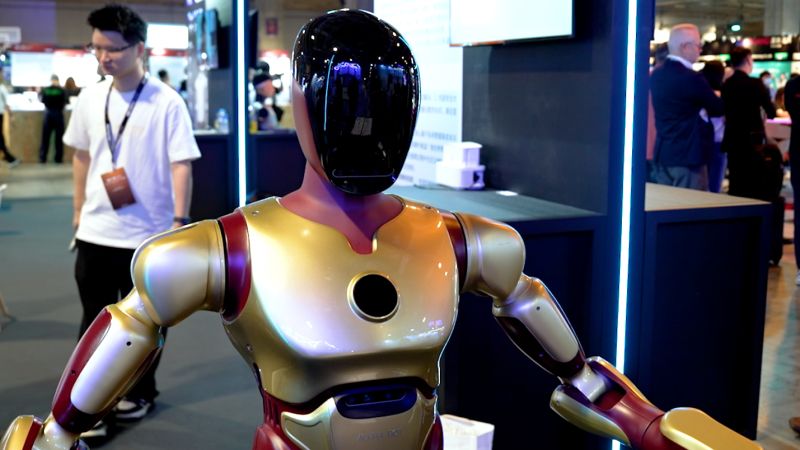### The Rise of Embodied AI: AlphaBot 2 Takes Center Stage
In a world where technology is evolving at a remarkable pace, AlphaBot 2 emerges as a frontrunner in a new wave of humanoid robots. This innovative machine, engineered by AI² Robotics from Shenzhen, China, has its sights set on outsmarting humans in traditional games. For instance, when asked to play dice, AlphaBot 2 showcases its remarkable capabilities by activating an automatic dice roller and sporting a thumbs-up gesture in response to opponents’ victories. This experience became a highlight at the recent Beyond Expo held in Macao, where attendees, including journalists from CNN, had the chance to witness its actions firsthand.
The success and dexterity of AlphaBot 2 stem from the implementation of embodied artificial intelligence (AI). This form of AI allows the robot to merge digital systems with tangible entities, thereby enabling it to interpret its surroundings and learn from experiences. Yandong Guo, the CEO of AI² Robotics, articulated this shift in technology, stating that previously, robots required explicit programming to execute tasks. The current generation of robots, however, possess the ability to autonomously comprehend instructions and their environment. Guo remarked during a conversation with CNN correspondent Kristie Lu Stout that it takes just a handful of demonstrations—typically five to ten—for the robot to master a new task.
While many may find conversational AI systems like ChatGPT to be familiar, experts agree that embodied AI represents the next significant evolution in technology. Numerous global corporations, including Tesla and the California-based Figure AI, are aggressively pursuing advancements in humanoid robotics, with backing from technology giants such as Microsoft and Nvidia. In China specifically, the development of embodied AI enjoys substantial governmental support, encompassing funding, innovation laboratories, and even formal education programs dedicated to robotics. Media reports suggest that Shenzhen alone hosts over 200 companies focused on this burgeoning field.
Governments recognize the potential for embodied AI to drive economic progress, spurring the creation of innovative robots capable of performing a variety of tasks. Some of these robots have surprisingly diverse skill sets, having been showcased performing advanced maneuvers like delivering a roundhouse kick or competing in marathons—albeit with a degree of slowness. Moreover, robots have already infiltrated sectors such as manufacturing, particularly automotive plants, where they manage routine functions. Harry Yang, an assistant professor at The Hong Kong University of Science and Technology, highlighted the transition toward embodied AI, stating that as tasks become increasingly complex, robots must evolve to interpret diverse scenarios adeptly.
AlphaBot 2 is already making a mark across numerous sectors, including industrial services and biotechnology. The robot utilizes AI² Robotics’ self-developed embodied AI model, with applications in factories such as one run by Dongfeng Liuzhou Motor Co. here it performs tasks like material handling, towed carts, and labeling windshields. Guo envisions a day when such robots might leave factory settings to become household aides. However, most robots currently fall short of the technological sophistication required for effective domestic assistance. Companies like UBTech Robotics have revealed plans for a home companion robot priced at $20,000, but experts point out that practical applications for chores and personal care are still years away.
Challenges in deploying home robots revolve primarily around acquiring sufficient training data to adapt to the myriad of different domestic environments encountered across consumers’ residences. Nonetheless, Morgan Stanley anticipates that up to 80 million humanoid robots could become commonplace in households by 2050 as technological improvements continue to explode through the industry.
Guo shares a vivid picture of how these future robots could simplify everyday tasks, imagining a scenario where a consumer simply requests a cup of tea, and the robot fetches the necessary ingredients and serves it. He also envisions post-meal cleanup being seamlessly handled by the machine. Despite these anticipations, the hurdles toward achieving widespread robotic integration into homes remain substantial. For one, the costs of robots must decrease significantly; AI² Robotics has refrained from presenting a fixed price for its humanoids, which are customized according to client needs. The spokesperson noted that projections could see their robots dropping to a price comparable to entry-level vehicles, making them accessible to more families.
However, Yang emphasizes that the high expenses involved in manufacturing these humanoids could deter individuals from investing in them, as hiring human help may prove to be a cheaper and more practical solution. Additionally, safety risks, particularly the potential for a robot to injure a person, alongside privacy concerns pertaining to data collection, further complicate their home integration. Despite these challenges, Guo noted that many consumers in China are still enthusiastic about adopting robotics for personal use.
Experts like Yang predict a timeline of five to ten years before humanoid robots are truly equipped to provide utility in homes. Meanwhile, AI² Robotics is planning to unveil its robots in major airport settings within China by the third quarter of 2025, tasked with managing luggage carts for passengers, with prospective use in











